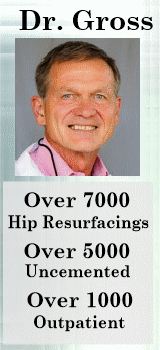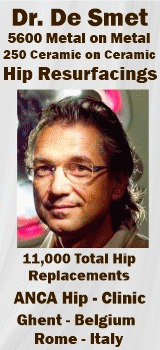Results of Hip Resurfacing at the Cleveland Clinic
Peter Brooks MD, FRCS(C)
www.clevelandclinic.org 216-444-4284
brooksp@ccf.orgI have been performing hip resurfacing at Cleveland Clinic using the Birmingham Hip Resurfacing System (BHR) since 2006, shortly after it became the first resurfacing device to be approved by the FDA. Two of my partners perform BHR as well. We also perform total hip replacement (THR).
I would agree with Dr Gross, "The Durability of Hip Resurfacing" on this site
http://www.surfacehippy.info/durability-hip-resurfacing-dr-gross-2012.php in his excellent rebuttal to an ongoing series of dubious studies and apples-to-oranges comparisons in the orthopedic literature, mass media, national registries, and personal series. I have been very pleased with the outstanding results of hip resurfacing when done in the right patient, using a properly designed device, with well placed implants.
At this time, I have implanted almost 1500 BHR devices. I would like to share our results, as published recently in the Journal of Bone and Joint Surgery, the premier medical journal of our field. We looked at patient age, gender, activity level, general health, complications, revisions, and functional outcomes, and compared these with our standard stemmed total hip replacements (THR).
We analyzed 678 BHR resurfacing patients with a 2 to 6-year follow-up, and compared these with 1221 THR patients in the same time period. The BHR resurfacing patients had an average age of 54, and 71% were male. In contrast, the THR patients had an average age of 63, and 45% were male.
The BHR resurfacing patients had better outcomes than the THR group: a shorter hospitalization, half the rate of readmission to hospital after discharge, and one-tenth the rate of re-operations (for such things as infections, dislocations, loosening, fracture etc) compared to THR. In addition, the BHR patients had higher functional scores at follow-up than our THRís, a difference which persisted even after statistical correction for age, gender and health status.
Looking at all the 1500 or so resurfacings that I have done, there have been remarkably few complications. One patient had a femoral neck fracture 6 years ago, and none since then. I have had no dislocations, no femoral loosening, one loose socket, and one infection. These complications are very infrequent when compared to reported results for traditional THR. One female patient fell down an escalator and broke her pelvis eventually needing a THR, and one patient had late head collapse (AVN). We have not seen any metal ion-related complications such as pseudotumors. Overall, the BHR in our center has a greater than 99% success rate at up to 6 years follow-up. These kinds of results have already been seen by experienced hip surgeons in other centers around the world, where the BHR has been available for 15 years.
I also agree with Dr Gross about the learning curve and level of difficulty involved in hip resurfacing. Step one of a traditional THR is cutting off the top 3-4 inches of the upper femur. This allows a wide surgical view of socket placement, where accurate positioning is the key to longevity of the implant. In resurfacing, however, the head and neck of the femur are not removed, so adequate exposure of the hip socket is difficult. A common place analogy would be trying to repair the engine of your car, but youíre not allowed to raise the hood more than a couple of inches. To accomplish this requires a lot of experience. In addition there is the challenge of getting the head (femoral) component in the correct position which is also an additional level of complexity when compared to a traditional THR. In my experience it takes most surgeons 100 procedures to get consistent accuracy of placement of the implants for hip resurfacing, and in some cases it may take many more cases to become an expert surgeon.
Most orthopedic surgeons do not do any resurfacing at all. Thatís probably a good thing. Most surgeons donít have the large number of patients that are good candidates for hip resurfacing to gain this level of surgical experience. And most surgeons who attend training courses realize itís not for them. Some hip surgeons with large practices do not recommend this procedure.
The only way to really be sure if you are a candidate for resurfacing is to get an opinion from a surgeon who does both traditional hip replacement and hip resurfacing. You can find many of us on this website
http://www.surfacehippy.info/listofdoctors.php , and almost all of us welcome e-mail inquiries, with X-rays
http://www.surfacehippy.info/xrayconversion.php Basically, anyone who does hip resurfacing does hip replacement as well, but the reverse is not necessarily true. Hip replacement and hip resurfacing do best in different types of patients. They are not competing procedures, they are complementary. The best candidates for resurfacing are young, healthy people who have higher levels of activity. These are some of the worst candidates for traditional total hip replacement because they have the highest rates of loosening and wear that require revision surgery.
The results reported for metal-on-metal total hip replacement cannot be directly applied to metal-on-metal hip resurfacing. The best resurfacing candidates are males under 65 with osteoarthritis. These patients do better with resurfacing than with THR. Inferior results are seen in women, hip dysplasia, and AVN.
You need to be the right patient, and have a properly placed implant, using an implant with a good track record to optimize your chances of getting a good long term result.
Disclosure: Dr Brooks collaborates with the medical device industry in the development of better implants and techniques for orthopedic patients. He is a consultant for Stryker and for Smith and Nephew, the company which manufactures the BHR. He receives no royalties for the BHR or for any other implant. This post is personal to Dr Brooks and does not necessarily reflect the opinions or positions of the Cleveland Clinic. Cleveland Clinic does not endorse any particular brand of medical device.











